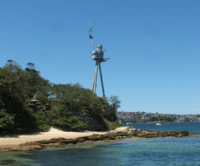Bradleys Head
Coordinates: 33°51′9″S 151°14′45″E / 33.85250°S 151.24583°E
Bradleys Head is a headland protruding from the north shore of Sydney Harbour, within the metropolitan area of Sydney, New South Wales, Australia. It is named after William Bradley. The original Aboriginal inhabitants belonged to the Borogegal clan of the Eora nation, and was known as Borogegy, Booraghee, Booragy or Burrogy. Also on the headland is an active lighthouse, Bradleys Head Light, constructed in 1905.[1]
Bradleys Head is now a unit of the Sydney Harbour National Park and managed by the National Parks and Wildlife Service.[2]
History

The foremast of the cruiser HMAS Sydney, renowned for taking part in the Royal Australian Navy's first ship against ship engagement in World War I, is mounted on the headland as a memorial to that battle. In June 2000 the mast was rededicated as a monument to all Australian ships and sailors lost in conflict.
The headland was also used for shooting of scenes for Mission: Impossible II (2000). A polystyrene house seen in the film was built on location, then removed after shooting was completed.
Sitting on the rock platform off the headland is a Doric stone column. It is one of six that were taken from the demolished Sydney Post Office and placed in positions in Sydney. In conjunction with the tower off Fort Denison, it was used for speed trials of vessels in Sydney Harbour. Owing to increased congestion on the Harbour, it is no longer used by the Maritime Services Board for this purpose.[3] (Another of the columns can be seen in the Mount Street Plaza, North Sydney.)
See also
- Clark Island
- Dobroyd Head
- Fort Denison
- Goat Island
- Middle Head
- Nielsen Park
- Rodd Island
- Shark Island
- Sydney Heads
References
- ↑ Rowlett, Russ. "Lighthouses of Australia: New South Wales". The Lighthouse Directory. University of North Carolina at Chapel Hill. Retrieved 2010-08-29.
- ↑ Carment, David (2010). "Bradleys Head". Dictionary of Sydney. Retrieved 28 March 2016.
- ↑ "Place ID 2875". Australian Heritage Database. Department of the Environment.
External links
- David Carment - Mosman Historical Society (2011). "Bradleys Head". Dictionary of Sydney. Dictionary of Sydney Trust. Retrieved 6 October 2015. [CC-By-SA]